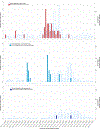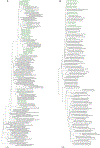Human infections with highly pathogenic avian influenza A(H5N1) viruses in the United States from March 2024 to May 2025
- PMID: 40712649
- PMCID: PMC12477757
- DOI: 10.1038/s41591-025-03905-2
Human infections with highly pathogenic avian influenza A(H5N1) viruses in the United States from March 2024 to May 2025
Abstract
Between March 2024 and October 2024, 46 human cases of highly pathogenic avian influenza (HPAI) A(H5N1) had been detected in the United States. The persistent panzootic spread of HPAI A(H5N1) viruses and continued detection of human cases presents an ongoing threat to public health. In this study, between November 2024 and May 2025, an additional 24 cases have been reported for a total of 70 human cases of HPAI A(H5N1): 41 were exposed to dairy cows, 24 to commercial poultry, two to backyard poultry and three had an unidentified source of exposure. All sequenced viruses were clade 2.3.4.4b. Overall, 62 cases (89%) reported eye redness, 32 (46%) fever and 29 (41%) respiratory symptoms; 54 of 67 cases (81%) reported receiving antiviral treatment. Most illnesses were mild; however, four patients were hospitalized. Of the hospitalized patients, three had pneumonia and one died. No human-to-human transmission was detected. Occupational exposure to infected animals was a risk factor for HPAI A(H5N1) virus infection and the risk to the general population remains low; however, the two cases exposed to infected backyard poultry and three cases with unidentified exposures highlight that ongoing vigilance is warranted.
© 2025. This is a U.S. Government work and not under copyright protection in the US; foreign copyright protection may apply.
Conflict of interest statement
Competing interests: The authors declare no competing interests.
Figures









References
-
- Webby RJ & Uyeki TM An Update on Highly Pathogenic Avian Influenza A(H5N1) Virus, Clade 2.3.4.4b. The Journal of infectious diseases 230, 533–542 (2024). - PubMed
-
- Nguyen TQ, et al. Emergence and interstate spread of highly pathogenic avian influenza A(H5N1) in dairy cattle in the United States. Science (New York, N.Y.) 388, eadq0900 (2025). - PubMed
Methods-only References
-
- Centers for Disease Control and Prevention. Highly Pathogenic Avian Influenza A(H5N1) Virus: Interim Recommendations for Prevention, Monitoring, and Public Health Investigations. https://www.cdc.gov/bird-flu/prevention/hpai-interim-recommendations.html (2024); Accessed on: May 7, 2025.
-
- Centers for Disease Control and Prevention. Health Alert Network: Accelerated Subtyping of Influenza A in Hospitalized Patients. (January 16, 2025). https://www.cdc.gov/han/php/notices/han00520.html?CDC_AA_refVal=https%3A....
-
- Centers for Disease Control and Prevention. U.S. Influenza Surveillance: Purpose and Methods. https://www.cdc.gov/fluview/overview/index.html (2025); Accessed on: May 7, 2025.
-
- Centers for Disease Control and Prevention. 2024–2025 Influenza Season: Surveillance For Novel Influenza A and Seasonal Influenza Viruses. https://www.cdc.gov/bird-flu/php/monitoring-bird-flu/surveillance-novel-.... (2024); Accessed on: June 24, 2025.
-
- World Health Organization. CDC Laboratory Support for Influenza Surveillance (CLSIS) SharePoint Site. https://cdn.who.int/media/docs/default-source/influenza/global-influenza... (2017); Accessed on: May 7, 2025.
MeSH terms
Grants and funding
LinkOut - more resources
Full Text Sources
Medical

